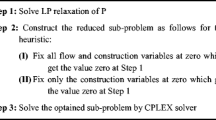Abstract
Transmission site selection and configuration for cellular networks is in general an NP-hard optimization problem. Consequently efforts to improve tractability are very valuable and meta-heuristic algorithms are now commonly applied in artificial intelligence frameworks and expert systems. The speed of network evaluation is a binding constraint on performance of meta-heuristic techniques. This is particularly challenging for CDMA-based systems because power allocation is required before coverage can be evaluated. The current most efficient heuristic for achieving this requires \(O(n^{2}_{\mathit{cell}} \cdot n_{\mathit{stp}})\) time where n cell is the number of cells and n stp is the number of active user locations. In the large-scale scenarios that arise in practice, n stp is large compared to n cell and consequently tractability is significantly impeded by n stp .
We introduce a new approach to improve tractability for the network planning problem. This concerns changing the resolution of the problem scenario by creating virtual entities which combine spatial traffic requirements, thus reducing the number of n stp that require evaluation. By solving a linear programming formulation of the planning problem exactly (for small instances) and using a heuristic (for large instances), we examine in detail the change in quality of solution that this method induces. The results show that only a marginal reduction in quality of network evaluation is observed, while computational tractability is improved.









Similar content being viewed by others
References
Amaldi, E., Capone, A., & Malucelli, F. (2003a). Planning UMTS base station location: optimization models with power control and algorithms. IEEE Transactions on Wireless Communications, 2(5), 939–952.
Amaldi, E., Capone, A., Malucelli, F., & Signori, F. (2003b). Optimization models and algorithms for downlink UMTS radio planning. In Proceedings of IEEE wireless communications and networking conference (Vol. 2, pp. 827–831).
Amaldi, E., Belotti, P., Capone, A., & Malucelli, F. (2006). Optimizing base station location and configuration in UMTS networks. Annals of Operations Research, 146, 135–151.
Ausiello, G., Crescenzi, P., Gambosi, G., Kann, V., Marchetti-Spaccamela, A., & Protasi, M. (1999). Complexity and approximation: combinatorial optimization problems and their approximability properties. Berlin: Springer.
Berruto, E., Gudmundson, M., Menolascino, R., Mohr, W., & Pizarroso, M. (1998). Research activities on UMTS radio interface, network architectures, and planning. IEEE Communications Magazine, 36, 82–95.
Calegari, P., Guidec, F., Kuonen, P., & Wagner, D. (1997). Genetic approach to radio network optimizations for mobile systems. In Proceedings of 47th IEEE vehicular technology conference (Vol. 2, pp. 755–759).
Cheung, J., Beach, M., & McGeehan, J. P. (1994). Network planning for third-generation mobile radio systems. IEEE Communications Magazine, 32, 54–59.
Hata, M. (1980). Empirical formula for propagation loss in land mobile radio services. IEEE Transactions on Vehicular Technology, VT-29(3), 317–323.
Hurley, S. (2002). Planning effective cellular mobile radio networks. IEEE Transactions on Vehicular Technology, 51(2), 243–253.
Karp, R. M. (1972). Reducibility among combinatorial problems. In R. E. Miller & J. W. Thatcher (Eds.), Complexity of computer computations (pp. 85–103). New York: Plenum Press.
Laiho, J., Wacker, A., & Novosad, T. (2002). Radio network planning and optimization for UMTS. Chichester: Wiley.
Lee, C., & Kang, H. (2000). Cell planning with capacity expansion in mobile communications: a tabu search approach. IEEE Transactions on Vehicular Technology, 49(5), 1678–1691.
Mathar, R., & Niessen, T. (2000). Optimum positioning of base stations for cellular radio networks. Wireless Networks, 6, 421–428.
Menolascino, R., Pizarroso, M., Lepschy, C., & Salas, B. (1998). Third generation mobile systems planning issues. In Proceedings of 48th IEEE vehicular technology conference (pp. 830–834).
Naghshineh, M., & Katzela, I. (1996). Channel assignment schemes for cellular mobile telecommunication systems: a comprehensive survey. IEEE Personal Communications, 3, 10–31.
Welsh, D. J. A., & Powell, M. B. (1967). An upper bound for the chromatic number of a graph and its application to timetabling problems. The Computer Journal, 10(1), 85–86.
Whitaker, R., Allen, S., & Hurley, S. (2009). Efficient off-line coverage and load evaluation for CDMA network modeling. IEEE Transactions on Vehicular Technology, 58(7), 3704–3712.
Eisenblatter, A., Geerdes, H. F., Koch, T., Martin, A., & Wessely, R. (2005). UMTS radio network evaluation and optimization beyond snapshots. Mathematical Methods of Operations Research, 63, 1–29.
Siomina, I., & Yuan, D. (2004). Optimization of pilot power for load balancing in WCDMA networks. In IEEE globecom (pp. 3872–3876).
Author information
Authors and Affiliations
Corresponding author
Additional information
The authors are supported by EPSRC grant EP/E020720/1.
Rights and permissions
About this article
Cite this article
Ghosh, S.C., Whitaker, R.M., Allen, S.M. et al. Dynamic data resolution to improve the tractability of UMTS network planning. Ann Oper Res 201, 197–227 (2012). https://doi.org/10.1007/s10479-012-1176-4
Published:
Issue Date:
DOI: https://doi.org/10.1007/s10479-012-1176-4




